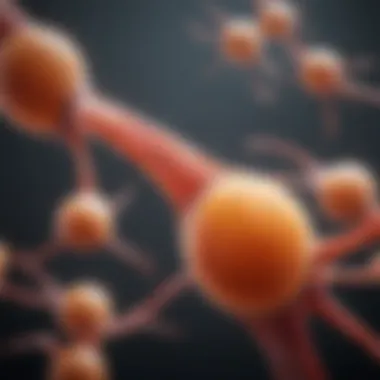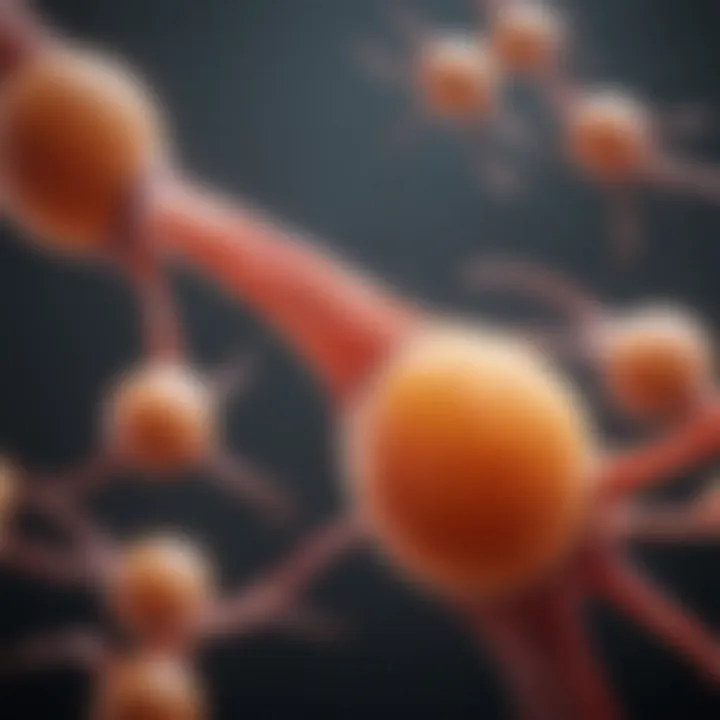Understanding Risk Factors for Bladder Cancer


Intro
Bladder cancer impacts thousands of individuals each year, making understanding its risk factors essential for prevention and awareness. The intricate relationship between genetics, environment, and lifestyle choices contributes to the complex landscape of this disease. Understanding these factors allows for targeted strategies that can potentially reduce incidence rates. Through this article, we will examine key risk factors that influence bladder cancer, providing a comprehensive overview suitable for students, researchers, and medical professionals.
Key Concepts and Terminology
Definition of Key Terms
To navigate the discussion of bladder cancer risk factors effectively, it is vital to comprehend certain terminologies used throughout this article. Here are some key terms:
- Bladder Cancer: A type of cancer that begins in the bladder, the organ that stores urine.
- Carcinogens: Substances capable of causing cancer in living tissue.
- Genetic Predisposition: The increased likelihood of developing a particular disease based on an individual's genetic makeup.
Concepts Explored in the Article
This article will delve into several interconnected concepts:
- Genetic influences and familial patterns of bladder cancer.
- Environmental and occupational exposures that elevate risk levels.
- The role of lifestyle choices, including tobacco use and diet.
- Health conditions that may heighten susceptibility, such as diabetes.
Findings and Discussion
Main Findings
Research suggests that various elements contribute to the likelihood of developing bladder cancer. Here are some key findings:
- Genetic Factors: About 25% of individuals diagnosed with bladder cancer may have a family history of the disease, indicating a genetic component.
- Environmental Exposures: Certain chemicals, notably aniline dyes and benzidine, found in industries such as rubber and textiles, are linked to increased risk.
- Lifestyle Choices: Smoking is a leading risk factor. Smokers are twice as likely to develop bladder cancer compared to non-smokers.
- Health Conditions: Chronic infections and diseases like diabetes are associated with higher chances of bladder cancer.
"Awareness of these risk factors is essential for early detection and preventive action."
Potential Areas for Future Research
While significant strides have been made in understanding bladder cancer risk factors, areas remain unexplored. Potential avenues for future research include:
- The impact of diet and nutrition on bladder cancer development.
- Genetic mutations that predispose certain populations to bladder cancer.
- Longitudinal studies assessing the effectiveness of preventive measures in high-risk groups.
A thorough examination of these findings provides a solid foundation for understanding bladder cancer risk.
In summary, bladder cancer poses a notable challenge to public health. Understanding the multifaceted risk factors involved helps illuminate pathways for prevention and early diagnosis. The interplay of genetic, environmental, and lifestyle elements underscores the need for continuous research and education within the medical community.
Overview of Bladder Cancer
Bladder cancer represents a significant health issue worldwide. Understanding this condition, its risk factors, and the demographics it affects is crucial for healthcare systems and individuals alike. This section will serve as a foundation for further discussion on the various contributing elements involved in bladder cancer.
Definition and Types
Bladder cancer arises when cells in the bladder begin to grow uncontrollably. The bladder is a hollow organ in the lower abdomen that stores urine. There are several types of bladder cancer, with urothelial carcinoma being the most common. This type begins in the urothelial cells that line the bladder. Other types include squamous cell carcinoma and adenocarcinoma, which are less common but can have significant implications on treatments and outcomes.
Bladder cancer classifications are also based on the stage of cancer, which ranges from superficial tumors, those confined to the inner layer of the bladder, to invasive forms that penetrate deeper into the bladder wall.
Prevalence and Statistics
Bladder cancer is among the most prevalent types of cancer, particularly in developed nations. The American Cancer Society highlights that in 2023, there will be an estimated 81,000 new cases of bladder cancer in the United States, with men being significantly more affected than women. The five-year survival rate varies according to the stage at diagnosis, with early detection greatly improving outcomes.
"Bladder cancer is the fourth most prevalent cancer in men, and it is crucial to understand the various risk factors to aid in prevention and early detection strategies."
Several factors influence the prevalence of bladder cancer. Age is a significant determinant, as the risk increases markedly in older adults. Additionally, factors such as smoking history, chemical exposure, and geographic variations contribute to the differences observed in various populations. Understanding these statistics is vital because they underscore the need for targeted awareness campaigns and health strategies.
Genetic Risk Factors
Genetic risk factors play a significant role in understanding bladder cancer. They highlight the inherent risks individuals may have based on their genetic makeup. Recognizing these factors enables targeted screening and prevention strategies.
Hereditary Predisposition
Hereditary predisposition involves the concept that certain genes can increase the likelihood of developing bladder cancer. Individuals with a family history of this cancer may be at a higher risk due to inherited genetic mutations. The most studied genes are TP53 and RB1, which are associated with tumor suppression. Those carrying mutations in these genes can experience an increased susceptibility.
While genetics provides a background, it is crucial to consider that not everyone will develop the disease even with a family history. Both genetic factors and environmental influences interact, shaping an individual's risk profile.
Molecular Genetics
Molecular genetics explores how specific genetic or molecular changes indicate the presence of bladder cancer. Mutations that impact cell cycle regulation lead to uncontrolled cell growth, a hallmark of cancer.
Recent studies highlight the importance of certain biomarkers, like fibroblast growth factor receptor 3 (FGFR3) mutations. These biomarkers can help identify patients at a higher risk. Additionally, alterations in the pathways controlling apoptosis may contribute to tumorigenesis. Understanding these molecular underpinnings provides clarity on how genetics and bladder cancer correlate.
Familial Patterns in Bladder Cancer
Familial patterns regarding bladder cancer reveal the complex interplay between genetics and environmental factors. Research indicates that first-degree relatives of bladder cancer patients may show a higher incidence. This suggests shared genetic factors or lifestyle choices within families that contribute to risk.
Some studies categorize these patterns into hereditary and sporadic cases. Hereditary cases often present at a younger age than sporadic ones. Contact with the same environmental carcinogens can also lead to clusters of bladder cancer cases in families. Identifying these patterns can enhance awareness and early detection, ultimately improving patient outcomes.


"Genetic factors can provide insight into an individual's risk, but they do not function in isolation."
In summary, genetic risk factors for bladder cancer emphasize the significance of hereditary predisposition and molecular changes. Recognizing familial patterns provides additional layers of understanding. Patients and families can benefit from this knowledge through informed decision-making and proactive health management.
Environmental Risk Factors
Environmental risk factors play a significant role in the development of bladder cancer. These factors include exposure to harmful substances, pollution, and lifestyle influences that vary with geographical locations. Examining these influences helps us understand better how our surroundings can impact health, particularly concerning bladder cancer. Factors like chemical exposure, polluted water sources, and the differences between urban and rural settings are crucial in this discussion.
Chemical Exposure
Chemical exposure is a prominent environmental risk associated with bladder cancer. Certain chemicals, known as carcinogens, can increase the likelihood of developing the disease. For instance, exposure to aromatic amines, which are found in dye and rubber industries, has been linked to bladder cancer. Moreover, chemicals like benzidine and beta-naphthylamine have been identified as high-risk agents in various studies.
Workers in industries where these chemicals are prevalent must utilize personal protective equipment and be aware of the risks. Prolonged exposure, even at low levels, can accumulate and lead to significant health risks. Therefore, regulations must be in place to minimize exposure and ensure safety in the workplace.
"Understanding the relationship between chemical exposure and bladder cancer is vital for preventative measures in at-risk occupations."
Polluted Water Sources
Access to clean water is crucial for health, but polluted water sources can pose a significant risk factor for bladder cancer. Contaminants in water, such as arsenic or pesticides, have been linked to increased cancer risk. Studies have shown that regions with high levels of these pollutants report higher instances of bladder cancer.
Local governments must monitor water quality consistently and provide necessary treatment to reduce contamination levels. In communities where pollution is an ongoing issue, public health initiatives should focus on raising awareness of the risks associated with poor water quality. Reducing exposure through filtration systems for households can also aid in mitigating these risks.
Urban vs. Rural Environments
The environment we live in, whether urban or rural, can influence the risk of bladder cancer. Urban areas often present higher levels of air and water pollution. The presence of industries, transportation emissions, and waste management systems contribute to an increased exposure to harmful substances. Consequently, urban residents may have a higher incidence of bladder cancer compared to their rural counterparts.
Conversely, rural areas might experience different exposures. Although they may have lower pollution levels, some rural communities face risks from agricultural chemicals, such as herbicides and fertilizers. Understanding these risks is crucial in formulating targeted prevention strategies. Public health messages should be tailored to specific communities to address their unique environmental concerns.
Overall, recognizing environmental risk factors related to bladder cancer is an essential step toward prevention and awareness. By understanding how these elements interact, it becomes possible to advocate for effective strategies aimed at reducing exposure and promoting health.
Occupational Hazards
Occupational hazards are crucial in understanding the risk factors associated with bladder cancer. Many individuals spend a significant portion of their lives at work, and exposure to certain environments and substances can increase their risk of developing various health conditions, including bladder cancer. Understanding these hazards helps to inform preventive strategies and raise awareness about the potential dangers present in specific industries.
It is essential to recognize that workplace environments can vary significantly. Therefore, identifying the specific hazards present in these spaces is paramount. Awareness of occupational risks not only contributes to individual health outcomes but also emphasizes the responsibility of employers to create safe working conditions.
Industries at Risk
Specifically, some industries have been linked to a higher incidence of bladder cancer due to exposure to hazardous substances. Several key sectors include:
- Chemical Manufacturing: Chemicals such as aniline dyes and benzidine are known carcinogens.
- Rubber Industry: Employees may come into contact with compounds that increase cancer risk.
- Paint and Dye Production: Certain pigments are associated with bladder cancer.
- Metal Workers: Exposure to cadmium and other metals is a growing concern.
- Textile Industry: Workers may face risks from chemical exposure in dye applications.
Workers in these sectors must understand the risks and advocate for safer practices. Additionally, ongoing research is vital to keep up with emerging threats in various industries.
Preventive Measures in the Workplace
Implementing preventive measures within the workplace can significantly reduce the risk of bladder cancer among workers. Effective strategies include:
- Regular Monitoring: Conduct regular assessments of chemical exposure levels.
- Proper Ventilation: Ensure adequate ventilation to minimize inhalation of harmful substances.
- Personal Protective Equipment (PPE): Provide suitable PPE, such as masks and gloves, to reduce risk of exposure.
- Employee Training: Educate workers on the potential hazards and best practices for handling toxic materials.
- Health Screening: Regular health check-ups for early detection of any adverse health effects associated with workplace exposure.
Mitigating occupational hazards is not just a legal obligation; it’s a moral imperative for protecting workers' health.
Creating a culture of safety and awareness can ultimately contribute to the well-being of employees and reduce the overall incidence of bladder cancer related to occupational exposure.
By implementing these preventive measures, industries can significantly reduce the risks faced by their workforce, promoting health and safety as a top priority.
Lifestyle Factors
Lifestyle factors play a crucial role in understanding the risk of developing bladder cancer. These factors are modifiable, meaning individuals have the ability to alter their habits to reduce their risk. Examining lifestyle choices such as tobacco use, diet, and physical activity levels provides valuable insights into how these elements can influence bladder cancer outcomes. This section emphasizes the significance of these factors while exploring their connections to bladder cancer risk, ultimately helping to inform preventive measures.
Tobacco Use
Tobacco use is one of the most significant lifestyle risk factors associated with bladder cancer. Smokers are at a higher risk compared to non-smokers, with studies indicating that individuals who smoke are three times more likely to develop the disease. This association stems from harmful chemicals in tobacco smoke that enter the bloodstream and can be excreted through urine, potentially damaging the bladder lining.
Moreover, even non-smokers who are exposed to secondhand smoke may face increased risk. The carcinogenic compounds found in cigarette smoke, such as aromatic amines and benzidine, are linked to bladder cancer development. Reducing or quitting tobacco use can significantly lower the risk. Support and resources for quitting are essential, as various cessation methods can aid individuals in overcoming dependence on tobacco products.
Diet and Nutrition
Diet and nutrition also have a direct impact on bladder health. A balanced diet rich in fruits, vegetables, and whole grains can provide essential nutrients that may offer protective effects against bladder cancer. Specific dietary components, such as vitamins A, C, and E, along with phytochemicals found in plant-based foods, may help reduce oxidative stress and inflammation in the bladder.
Conversely, high intake of processed meats and known carcinogens can elevate the risk. Maintaining hydration is similarly important; drinking adequate amounts of water helps dilute harmful substances in urine, reducing the likelihood of damage to the bladder. Adopting a nutritious diet, alongside regular medical check-ups, enhances overall health and may play a crucial role in lowering risk.
Physical Activity Levels
Physical activity levels also contribute to bladder cancer risk. Numerous studies suggest that regular exercise reduces the likelihood of developing several cancers, including bladder cancer. Physical activity helps maintain a healthy weight, which is factored in as a possible risk modifier for bladder cancer.
Additionally, engaging in moderate to vigorous exercise may enhance overall bodily functions and contribute to better immune responses. It is recommended that adults engage in at least 150 minutes of moderate aerobic activity weekly. Incorporating physical activity doesn't have to be structured; it can include walking, biking, gardening, or even active play with children. Building a routine of regular exercise can be a practical approach to mitigate the risk of bladder cancer while improving general health.
In summary, lifestyle factors such as tobacco use, diet, and physical activity levels are instrumental in influencing bladder cancer risk. Understanding and modifying these factors can lead to better health outcomes and potentially lower the rates of this significant disease.


Health Conditions and Treatments
The relationship between health conditions and treatments with bladder cancer is an essential aspect to understand when assessing risk factors. Various chronic health problems can either directly increase the likelihood of developing bladder cancer or serve as complications in its management. Additionally, treatments for other conditions, particularly those involving the urinary system, can have long-lasting effects that potentially elevate cancer risk.
Chronic Urinary Conditions
Chronic urinary conditions, such as interstitial cystitis and bladder stones, can impact bladder health over time. Those with interstitial cystitis may experience inflammation that leads to bladder wall changes, which some studies suggest may predispose patients to cancer. Bladder stones can also cause irritation and recurrent urinary infections. Therefore, ongoing management of these conditions is critical not only for immediate symptoms but also for minimizing long-term risks.
Key considerations for chronic urinary conditions:
- Regular monitoring and management to reduce inflammation
- Understanding the potential link between chronic conditions and bladder cancer
- Importance of early medical consultation when symptoms arise
History of Bladder Infections
A history of bladder infections, particularly recurrent urinary tract infections (UTIs), is a notable risk factor. Chronic inflammation from frequent infections can alter the urgent health of the bladder lining. While most bladder infections do not lead to cancer, the cumulative effects of repeated infections over many years may elevate risk. Individuals with a history of infection should be vigilant about their urinary health and consider regular check-ups.
Persistent urinary tract infections may increase the risk of bladder cancer through ongoing irritation and inflammation.
Impact of bladder infections can include:
- Changes in the bladder lining, leading to cellular atypia
- Increased need for antibiotics, potentially harmful in long-term
- More frequent medical visits, enhancing awareness
Chemotherapy and Other Treatments
Finally, it is imperative to consider how chemotherapy and other treatments for various cancers may influence bladder cancer risk. Certain chemotherapy drugs, particularly those used to treat other forms of cancer, have been associated with an increased risk of bladder cancer later on. Treatments such as cyclophosphamide increase the likelihood of transitional cell carcinoma of the bladder.
Factors to keep in mind with chemotherapy and treatments include:
- Monitoring for bladder health after receiving known carcinogenic therapies
- Possible side effects that may lead to urinary conditions
- Importance of discussing long-term risks with oncologists
Understanding how these health conditions and treatments intersect with bladder cancer risk offers a more comprehensive view of prevention and detection strategies. Recognizing these links is crucial for both patients and healthcare providers in the quest for better health outcomes.
Demographic Factors
Demographic factors play a crucial role in understanding the risk factors associated with bladder cancer. By examining elements such as age, gender, and race, we can gain insights into how these variables influence the likelihood of developing the disease. This section will provide a detailed look into how demographic characteristics can inform prevention strategies and awareness programs.
Age and Gender Influences
Age is one of the most significant risk factors for bladder cancer. The incidence of this disease increases with advancing age, particularly in individuals over 55 years. The majority of bladder cancer cases are diagnosed in those aged 65 and older. This trend underscores the importance of age as a demographic factor in cancer research and patient education.
Gender is another important component. Men are more likely to develop bladder cancer compared to women, with studies suggesting a ratio of approximately 3:1. The reasons behind this disparity can be complex. It may involve factors such as lifetime exposure to carcinogens, differences in biological response to environmental risks, and lifestyle choices. Awareness of these influences is essential for tailoring screening and preventive measures effectively.
In summary, age and gender significantly affect not only the risk but also the prognosis of bladder cancer. By understanding these factors, healthcare providers can create more informed screening guidelines that account for these demographic aspects.
Ethnic and Racial Disparities
Ethnic and racial factors also contribute to bladder cancer risk. Certain racial groups show higher incidence rates and mortality related to bladder cancer. For instance, studies indicate that Caucasians have a higher risk compared to African Americans and Hispanics. However, survival rates can differ among these groups, suggesting that genetic factors, access to healthcare, and potential variations in lifestyle are at play.
Members of specific ethnic groups may experience unique environmental exposures or have different genetic predispositions that make them more susceptible to developing bladder cancer. For example, the incidence of bladder cancer is particularly high among European and Middle Eastern populations.
Understanding these disparities can enhance public health initiatives and research efforts targeted at at-risk communities. By addressing these demographic risk factors, we can better focus educational campaigns and resources toward groups that may benefit the most from increased awareness and preventive actions.
"Recognizing the impact of demographic factors is essential for comprehensive cancer control strategies and equitable healthcare delivery.
Psychosocial Aspects
The role of psychosocial factors in the understanding of bladder cancer risk is often overlooked. However, these elements significantly impact patients' mental well-being, their coping strategies, and ultimately their response to the disease. Psychosocial aspects encompass a range of factors including mental health, social support, and coping mechanisms that form an individual's interaction with their health.
A key point is that mental health issues like anxiety and depression can arise from a cancer diagnosis, affecting both the quality of life and the treatment outcomes. Studies indicate that patients who experience mental health challenges may be less likely to adhere to treatment recommendations, potentially hindering recovery.
Impact of Mental Health
Mental health directly influences how patients approach their diagnosis and manage their illness. Those with pre-existing mental health disorders are often at a greater risk of experiencing severe psychological distress when faced with bladder cancer. The stress of diagnosis, combined with treatment uncertainties, can create a cycle of fear and anxiety.
- Prevention of Mental Health Decline: Early identification of mental health issues is crucial as it allows for timely intervention. Some patients benefit from counseling services or support groups that understand the complexities of their situation.
- Support Systems: Strong social support networks can ameliorate some of the negative effects associated with a cancer diagnosis. Family, friends, and support groups provide emotional backing and practical help, which can lead to better overall health outcomes.
Stress and Coping Mechanisms
The way in which individuals cope with stress associated with a bladder cancer diagnosis can vary widely. Effective coping strategies are critical for emotional resilience. Among the various mechanisms, some approaches can enhance one's psychological well-being:
- Emotion-Focused Coping: Techniques that focus on managing emotions rather than the problem itself, such as meditation or mindfulness, have proven beneficial.
- Problem-Focused Coping: Taking action to address practical problems—whether through seeking medical advice or accessing educational resources about the disease—can create a sense of control.
"Coping effectively means recognizing the stressors and adopting strategies that work best for the individual."
- Lifestyle Changes: Integrating physical activities, maintaining a healthy diet, and avoiding harmful substances can also serve as effective coping mechanisms, providing both physical and psychological benefits.
Understanding these psychosocial factors is vital in creating comprehensive care strategies for bladder cancer patients. Clinicians and healthcare providers should incorporate mental health assessments alongside traditional medical evaluations to offer a holistic approach to patient care.
Prevention and Awareness


The significance of prevention and awareness in bladder cancer cannot be overstated. Understanding how to mitigate risks and recognize early signs of the disease is vital for reducing incidence rates and improving outcomes. This section delves into several essential elements of prevention and awareness, each contributing to a cohesive strategy against bladder cancer.
Public Health Campaigns
Public health campaigns are instrumental in increasing awareness about bladder cancer. These initiatives educate communities about risk factors, promote healthy behaviors, and encourage early detection. Often, campaigns employ various media formats to deliver messages effectively. Graphic advertisements, social media posts, and community health fairs all serve as platforms to spread knowledge.
Crucial topics covered in these campaigns typically include:
- The role of smoking in bladder cancer risk.
- Importance of hydration and avoiding harmful chemicals.
- Outreach to high-risk populations for specialized screenings.
Engaging with people in relatable ways can foster better understanding and encourage proactive health discussions. People should know how vital it is to recognize symptoms early.
Screening and Early Detection
Screening for bladder cancer is another critical element in prevention efforts. Early detection greatly increases the success rate of treatment. Individuals at higher risk, especially those aged 55 and older or those with a smoking history, should consider regular screenings. These screenings can involve urine tests, cystoscopy, and imaging techniques. Discussing personal risk factors with a healthcare provider reinforces the importance of these measures.
Evidence from various studies suggests that:
- Frequent urinary symptoms should prompt immediate medical attention.
- Routine screenings can potentially uncover precancerous changes.
- The frequency of screenings should align with personal risk levels as assessed by a healthcare professional.
Moreover, awareness efforts should focus on patient education about the screening process and what to expect, thus alleviating anxiety related to medical examinations.
Healthy Lifestyle Choices
Choosing a healthy lifestyle is a proactive way to combat bladder cancer. Research indicates that certain lifestyle decisions can significantly reduce risk. Knowledge about these choices must be shared extensively. This includes:
- Avoiding tobacco products, which are proven to increase the likelihood of developing bladder cancer.
- Staying well-hydrated. Drinking enough water helps to dilute potential carcinogens in the urine.
- Eating a balanced diet high in fruits and vegetables, which are rich in antioxidants that may reduce cancer risk.
- Regular physical activity, which can help maintain a healthy weight and lower the risk of various cancers.
A blend of community support and educational resources enhances the likelihood of individuals adopting and maintaining these healthy habits. Encouraging these lifestyle choices is essential for long-term prevention.
"Being aware of risk factors and engaging in preventative measures can directly impact bladder cancer outcomes."
The integration of community initiatives, screening strategies, and healthy lifestyles provides a comprehensive approach to bladder cancer prevention and fosters a more informed public. Through continuous education and encouraging responsible health choices, the fight against bladder cancer can become more effective.
Future Research Directions
Research into bladder cancer continues to evolve, driven by the need to better understand the complex factors contributing to its development. One of the essential aspects of this field is identifying future research directions that can offer new insights, improve early detection, and ultimately lead to better treatment options. This is particularly significant as bladder cancer presents with a unique set of risk factors that vary across populations. New studies may focus on integrating genetics with environmental influences and lifestyle choices. Understanding these interactions can reveal potentially modifiable risk factors that may not be clear at present.
Further, research efforts may involve examining the molecular mechanisms underlying bladder cancer, which could provide clarity on how certain behaviors or exposures lead to cellular changes. Such knowledge is vital for developing targeted prevention strategies.
In the face of rising incidences, awareness of bladder cancer remains crucial. Engaging the scientific community and encouraging inter-disciplinary collaborations will facilitate novel approaches in combating this disease.
Emerging Studies
Emerging studies in bladder cancer research can potentially reshape our understanding of the disease. New theories about genetic predispositions, epigenetic modifications, and the role of microbiomes are gaining traction. Research is being conducted to analyze specific genetic mutations associated with bladder cancer, such as mutations in the FGFR3 or TP53 genes.
These studies explore the possibility of targeted therapies that could improve outcomes for patients with specific genetic profiles. They focus on:
- Genetic screening: Identifying individuals with increased susceptibility due to inherited mutations.
- Biomarker discovery: Developing reliable biomarkers that can aid in diagnosis and prognosis.
Additionally, epidemiological studies are investigating the link between lifestyle factors and bladder cancer across different populations. This includes addressing how diet, physical activity, and smoking prevalence interact with demographic variables like age and sex.
"Understanding the diverse factors that influence bladder cancer will enhance our ability to devise effective interventions and treatment plans."
Technological Advancements in Detection
Technological advancements in bladder cancer detection signify a significant leap in improving clinical outcomes. Innovations such as non-invasive urine tests are emerging, reducing the need for more invasive procedures like cystoscopy. These advancements bring hope for earlier diagnosis and better patient experience.
Recent developments include:
- Urinary biomarkers: Tests that detect specific proteins or genetic material in urine samples, which can indicate malignancy.
- Imaging techniques: Enhanced imaging technology, such as MRI and PET scans, provides more accurate assessments of bladder anomalies.
Moreover, artificial intelligence (AI) is being employed to analyze imaging results and patient data more efficiently. This technology can enhance the accuracy of early detection by identifying patterns that may go unnoticed by human analysis.
Altogether, these advancements demonstrate the role of innovation in improving detection and management of bladder cancer. Fostering continued investment into these technologies will be integral for future breakthroughs.
Epilogue
The conclusion section serves as a pivotal moment in the discourse surrounding bladder cancer. This complexity of the disease is underscored by its varied risk factors. Addressing these factors is crucial for improved treatment strategies and public health outcomes. For the reader, understanding these elements aligns with empowerment through knowledge. It also fosters a proactive approach towards prevention, enabling individuals to make informed decisions about their health.
Summary of Key Findings
In analyzing risk factors for bladder cancer, several key findings emerge:
- Genetic Factors: Certain genetic predispositions can increase susceptibility.
- Environmental Influences: Chemical exposure and pollution significantly contribute to risk.
- Lifestyle Choices: Smoking and poor diet have been shown to elevate risk levels.
- Health Conditions: Previous urinary conditions or infections can play a role in the likelihood of developing cancer.
These findings not just illuminate the causal relationships but also stress the importance of comprehensive strategies that incorporate genetic knowledge, environmental assessments, and lifestyle modifications.
Call for Continued Research
Ongoing research is essential to advance our understanding of bladder cancer's risk factors. Here are some avenues for continued exploration:
- Longitudinal Studies: Examining long-term environmental impacts on groups at risk can provide deeper insights.
- Genetic Research: Investigating specific genes tied to bladder cancer can help develop targeted therapies.
- Lifestyle Impact Studies: Understanding how changes in diet and physical activity affect risk can inform public health recommendations.
Further studies are not only necessary but are crucial for refining prevention strategies. Continuing to unveil the intricate web of risk factors will enhance both individual and collective health outcomes.







